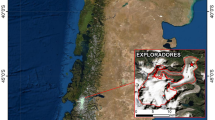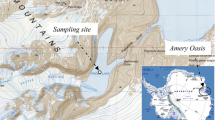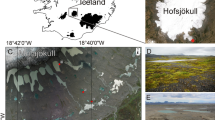Abstract
Cryoconite holes are small ponds that form on the surface of glaciers that contain a dark debris, the cryoconite, at the bottom and host active ecological communities. Differences in the structure of bacterial communities have been documented among Arctic and mountain glaciers, and among glaciers in different areas of the world. In this study, we investigated the structure of bacterial communities of cryoconite holes of Baltoro Glacier, a large (62 km in length and 524 km2 of surface) glacier of the Karakoram, by high-throughput sequencing of the V5-V6 hypervariable regions of the 16S rRNA gene. We found that Betaproteobacteria dominated bacterial communities, with large abundance of genera Polaromonas, probably thanks to its highly versatile metabolism, and Limnohabitans, which may have been favoured by the presence of supraglacial lakes in the area where cryoconite holes were sampled. Variation in bacterial communities among different sampling areas of the glacier could be explained by divergent selective processes driven by variation in environmental conditions, particularly pH, which was the only environmental variable that significantly affected the structure of bacterial communities. This variability may be due to both temporal and spatial patterns of variation in environmental conditions.




Similar content being viewed by others
References
Anesio AM, Laybourn-Parry J (2012) Glaciers and ice sheets as a biome. Trends Ecol. Evol. 27:219–225. doi:10.1016/j.tree.2011.09.012
Laybourn-Parry J, Tranter M, Hodson A (2012) The ecology of snow and ice environments. Oxford University Press, Oxford
Margesin R, Schinner F, Marx JC, Gerday C (2008) Psychrophiles: from biodiversity to biotechnology. Springer, Berlin
Boetius A, Anesio AM, Deming JW, et al. (2015) Microbial ecology of the cryosphere: sea ice and glacial habitats. Nat Rev Microbiol 13:677–690. doi:10.1038/nrmicro3522
Stibal M, Šabacká M, Žárský J (2012) Biological processes on glacier and ice sheet surfaces. Nat Geosci 5:771–774. doi:10.1038/ngeo1611
MacDonell S, Fitzsimons S (2008) The formation and hydrological significance of cryoconite holes. Prog Phys Geogr 32:595–610. doi:10.1177/0309133308101382
Mihalcea C, Mayer C, Diolaiuti G, et al. (2006) Ice ablation and meteorological conditions on the debris-covered area of Baltoro glacier, Karakoram, Pakistan. Ann Glaciol 43:292–300. doi:10.3189/172756406781812104
Wharton RA, McKay CP, Simmons GM, Parker BC (1985) Cryoconite holes on glaciers. Bioscience 35:499–503. doi:10.2307/1309818
Cook J, Edwards A, Takeuchi N, Irvine-Fynn T (2015) Cryoconite: the dark biological secret of the cryosphere. Prog Phys Geogr 40:66–111. doi:10.1177/0309133315616574
Musilova M, Tranter M, Bamber JL, Takeuchi N, Anesio A (2016) Experimental evidence that microbial activity lowers the albedo of glaciers. Geochemical Perspectives Letters 106–116
Säwström C, Mumford P, Marshall W, et al. (2002) The microbial communities and primary productivity of cryoconite holes in an Arctic glacier (Svalbard 79°N). Polar Biol 25:591–596
Stibal M, Tranter M, Benning LG, Rěhák J (2008) Microbial primary production on an Arctic glacier is insignificant in comparison with allochthonous organic carbon input. Environ Microbiol 10:2172–2178
Segawa T, Ishii S, Ohte N, et al. (2014) The nitrogen cycle in cryoconites: naturally occurring nitrification-denitrification granules on a glacier. Environ. Microbiol. 16:3250–3262. doi:10.1111/1462-2920.12543
Edwards A, Mur LAJ, Girdwood SE, et al. (2014) Coupled cryoconite ecosystem structure-function relationships are revealed by comparing bacterial communities in alpine and Arctic glaciers. FEMS Microbiol. Ecol. 89:222–237. doi:10.1111/1574-6941.12283
Edwards A, Pachebat JA, Swain M, et al. (2013) A metagenomic snapshot of taxonomic and functional diversity in an alpine glacier cryoconite ecosystem. Environ. Res. Lett. 8:35003. doi:10.1088/1748-9326/8/3/035003
Franzetti A, Navarra F, Tagliaferri I, Gandolfi I, Bestetti G, Minora U, Azzoni RS, Diolaiuti G, Smiraglia C, Ambrosini R (2016) Temporal variability of bacterial communities in cryoconite on an Alpine glacier. (2016) Environ Microbiol Rep. doi:10.1111/1758-2229.12499
Takeuchi N, Kohshima S, Seko K (2001) Structure, formation, and darkening process of albedo-reducing material (cryoconite) on a Himalayan glacier: a granular algal mat growing on the glacier. Arctic, Antarct Alp Res 33:115–122
Takeuchi N, Nishiyama H, Li Z (2010) Structure and formation process of cryoconite granules on Ürümqi glacier no. 1, Tien Shan, China. Ann. Glaciol. 51:9–14. doi:10.3189/172756411795932010
Minora U, Bocchiola D, D’Agata C, et al. (2013) 2001–2010 glacier changes in the central Karakoram National Park: a contribution to evaluate the magnitude and rate of the “Karakoram anomaly”. Cryosph Discuss 7:2891–2941. doi:10.5194/tcd-7-2891-2013
Franzetti A, Tagliaferri I, Gandolfi I, et al. (2016) Light-dependent microbial metabolisms driving carbon fluxes on glacier surfaces. ISME J 10:2984–2988. doi:10.1038/ismej.2016.72
Minora U, Senese A, Bocchiola D, et al. (2015) A simple model to evaluate ice melt over the ablation area of glaciers in the central Karakoram National Park, Pakistan. Ann Glaciol 56:202–216. doi:10.3189/2015AoG70A206
Tatangelo V, Franzetti A, Gandolfi I, et al. (2014) Effect of preservation method on the assessment of bacterial community structure in soil and water samples. FEMS Microbiol Lett 356:32–38. doi:10.1111/1574-6968.12475
Telling J, Anesio AM, Hawkings J, et al. (2010) Measuring rates of gross photosynthesis and net community production in cryoconite holes: a comparison of field methods. Ann Glaciol 51:153–162
ASTM (2000) Standard Test Methods for Moisture, Ash, and Organic Matter of Peat and Other Organic Soils - Method D 2974-00. American Society for Testing and Materials, West Conshohocken
Hodson A, Cameron K, Bøggild C, et al. (2010) The structure, biological activity and biogeochemistry of cryoconite aggregates upon an Arctic valley glacier: Longyearbreen, Svalbard. J Glaciol 56:349–362. doi:10.3189/002214310791968403
Edgar RC (2013) UPARSE: highly accurate OTU sequences from microbial amplicon reads. Nat. Methods 10:996–998. doi:10.1038/nmeth.2604
Wang Q, Garrity GM, Tiedje JM, Cole JR (2007) Naive Bayesian classifier for rapid assignment of rRNA sequences into the new bacterial taxonomy. Appl Environ Microbiol 73:5261–5267. doi:10.1128/AEM.00062-07
Legendre P, Legendre L (1998) Numerical ecology, 2nd English edn. Elsevier, Amsterdam
Borcard D, Legendre P, Drapeau D (1992) Partialling out the Spatial Component of Ecological Variation. Ecology 73(3):1045–1055
Borcard D, Gillet F, Legendre F (2011) Numerical ecology with R. Springer, New York
Blanchet G, Legendre P, Borcard D (2008) Forward selection of spatial explanatory variables. Ecology 89:2623–2632. doi:10.1890/07-0986.1
R Core Team (2013) R: A language and environment for statistical computing. R Foundation for Statistical Computing, Vienna
Shannon CE (1948) A mathematical theory of communication. Bell Syst Tech J 27:379–423. doi:10.1145/584091.584093
GiniC (1912) Variabilità e Mutabilità. Contributo allo studio delle distribuzioni e delle relazioni statistiche. C. Cuppini, Bologna
Wittebolle L, Marzorati M, Clement L, et al. (2009) Initial community evenness favours functionality under selective stress. Nature 458:623–626. doi:10.1038/nature07840
Schielzeth H, Forstmeier W (2009) Conclusions beyond support: overconfident estimates in mixed models. Behav Ecol 20:416–420. doi:10.1093/beheco/arn145
Benjamini Y, Yekutieli D (2001) The control of the false discovery rate in multiple testing under dependency. Ann Stat 29:1165–1188
Hartmann M, Howes CG, VanInsberghe D, et al. (2012) Significant and persistent impact of timber harvesting on soil microbial communities in northern coniferous forests. ISME J 6:2199–2218. doi:10.1038/ismej.2012.84
Legendre P, Andersson MJ (1999) Distance-based redundancy analysis: testing multispecies responses in multifactorial ecological experiments. Ecol Monogr 69:1–24. doi:10.1890/0012-9615
Oksanen J, Blanchet FG, Kindt R, et al. (2015) vegan: Community Ecology Package. R package version 2.3-0. http://CRAN.R-project.org/package=vegan Accessed 15 Dec 2016
De Cáceres M, Legendre P, Moretti M (2010) Improving indicator species analysis by combining groups of sites. Oikos 119:1674–1684. doi:10.1111/j.1600-0706.2010.18334.x
Griffith DA, Peres-Neto PR (2006) Spatial modeling in ecology: the flexibility of Eigenfunction spatial analyses. Ecology 87:2603–2613. doi:10.1890/0012-9658
Borcard D, Legendre P (2002) All-scale spatial analysis of ecological data by means of principal coordinates of neighbour matrices. Ecol Model 153:51–68. doi:10.1016/S0304-3800(01)00501-4
Legendre P, Legendre L (2012) Numerical ecology, 3rd English Ed. Elsevier Science B.V, Amsterdam
Hell K, Edwards A, Zarsky J, et al. (2013) The dynamic bacterial communities of a melting high Arctic glacier snowpack. ISME J 7:1814–1826. doi:10.1038/ismej.2013.51
Musilova M, Tranter M, Bennett SA, et al. (2015) Stable microbial community composition on the Greenland icesheet. Front Microbiol 6:193 doi:10.3389/fmicb.2015.00193
Jangid K, Whitman WB, Condron LM, et al. (2013) Soil bacterial community succession during long-term ecosystem development. Mol Ecol 22:3415–3424. doi:10.1111/mec.12325
Philippot L, Tscherko D, Bru D, Kandeler E (2011) Distribution of High Bacterial Taxa Across the Chronosequence of Two Alpine Glacier Forelands. Microb Ecol 61(2):303-312
Darcy JL, Lynch RC, King AJ, et al. (2011) Global distribution of Polaromonas phylotypes - evidence for ahighly successful dispersal capacity. PLoS One. doi:10.1371/journal.pone.0023742
Franzetti A, Tatangelo V, Gandolfi I, et al. (2013) Bacterial community structure on two alpine debris-covered glaciers and biogeography of Polaromonas phylotypes. ISME J 7:1483–1492. doi:10.1038/ismej.2013.48
Michaud L, Caruso C, Mangano S, et al. (2012) Predominance of Flavobacterium, pseudomonas, and Polaromonas within the prokaryotic community of freshwater shallow lakes in the northern Victoria land, East Antarctica. FEMS Microbiol. Ecol. 82:391–404. doi:10.1111/j.1574-6941.2012.01394.x
Mattes TE, Alexander AK, Richardson PM, et al. (2008) The genome of Polaromonas sp. strain JS666: insights into the evolution of a hydrocarbon- and xenobiotic-degrading bacterium, and features of relevance to biotechnology. Appl Environ Microbiol 74:6405–6416. doi:10.1128/AEM.00197-08
Wang Z, Chang X, Yang X, et al. (2014) Draft genome sequence of Polaromonas glacialis strain R3-9, a Psychrotolerant bacterium isolated from Arctic glacial foreland. Genome Announc 2:e00695–e00614. doi:10.1128/genomeA.00695-14
Yagi JM, Sims D, Brettin T, Bruce D, Madsen EL (2009) The genome of strain CJ2, isolated from coal tar-contaminated sediment, reveals physiological and metabolic versatility and evolution through extensive horizontal gene transfer. Environ Microbiol 11(9):2253–2270
Kasalický V, Jezbera J, Hahn MW, Šimek K (2013) The diversity of the Limnohabitans genus, an important group of freshwater bacterioplankton, by characterization of 35 isolated strains. PLoS One 8:e58209. doi:10.1371/journal.pone.0058209
Caliz J, Casamayor EO (2014) Environmental controls and composition of anoxygenic photoheterotrophs in ultraoligotrophic high-altitude lakes (central pyrenees). Environ. Microbiol Rep 6:145–151. doi:10.1111/1758-2229.12142
Zeng Y, Kasalický V, Šimek K, Koblížeka M (2012) Genome sequences of two freshwater betaproteobacterial isolates, Limnohabitans species strains Rim28 and Rim47, indicate their capabilities as both photoautotrophs and ammonia oxidizers. J Bacteriol 194:6302–6303. doi:10.1128/JB.01481-12
Cameron KA, Hodson AJ, Osborn AM (2012) Structure and diversity of bacterial, eukaryotic and archaeal communities in glacial cryoconite holes from the Arctic and the Antarctic. FEMS Microbiol. Ecol. 82:254–267. doi:10.1111/j.1574-6941.2011.01277.x
Waidner LA, Kirchman DL (2008) Diversity and distribution of ecotypes of the aerobic anoxygenic phototrophy gene pufM in the Delaware estuary. Appl Environ Microbiol 74:4012–4021. doi:10.1128/AEM.02324-07
Jiao N, Zhang Y, Zeng Y, et al. (2007) Distinct distribution pattern of abundance and diversity of aerobic anoxygenic phototrophic bacteria in the global ocean. Environ Microbiol 9:3091–3099. doi:10.1111/j.1462-2920.2007.01419.x
Fierer N, Bradford MA, Jackson RB (2007) Toward an ecological classification of soil bacteria. Ecology 88:1354–1364. doi:10.1890/05-1839
Cameron KA, Stibal M, Zarsky JD, et al. (2016) Supraglacial bacterial community structures vary across the Greenland ice sheet. FEMS Microbiol Ecol. doi:10.1093/femsec/fiv164
Gokul JK, Hodson AJ, Saetnan ER, et al. (2016) Taxon interactions control the distributions of cryoconite bacteria colonizing ahigh Arctic ice cap. Mol Ecol. doi:10.1111/mec.13715
Acknowledgements
Authors thank Science for Life Sequencing facility (Stockholm, Sweden) for sequencing and the Central Karakoram National Park (CKNP, Pakistan) for hosting and supporting our field investigations. Some bioinformatics analyses have been run on PLX server (CINECA, Bologna, Italy).
Author information
Authors and Affiliations
Corresponding author
Ethics declarations
Funding
This work was partially funded by PAPRIKA project (supported by EvK2CNR Association), by SEED project (funded by the Italian and the Pakistani governments), by the Italian Ministry of Research [PRIN grant 2010AYKTAB to CS] and by the University of Milano-Bicocca (grant 7-19-2001100-2 to RA).
Electronic supplementary material
ESM 1
(PDF 733 kb)
Rights and permissions
About this article
Cite this article
Ambrosini, R., Musitelli, F., Navarra, F. et al. Diversity and Assembling Processes of Bacterial Communities in Cryoconite Holes of a Karakoram Glacier. Microb Ecol 73, 827–837 (2017). https://doi.org/10.1007/s00248-016-0914-6
Received:
Accepted:
Published:
Issue Date:
DOI: https://doi.org/10.1007/s00248-016-0914-6




